Ladies and Gentlemen, we introduce you to Tim Shelbourne and welcome his Photoshop expertise to this issue of DTG! Welcome Tim, and thank you so much for sharing this tutorial...
Photo to Pencil Sketch
[Editor's Note: Folks, we regularly get two or more requests from readers for any help using Photoshop to convert a photo to a sketch -- pencil, charcoal, conte, or other mediums. This is by far the very best tutorial we've seen to date -- bar none! When we saw this technique in the Photoshop Photo Effects Cookbook we knew at once we had to share it with you! Thanks to O'Reilly Publishing we're able to bring the technique to you in its entirety! ]
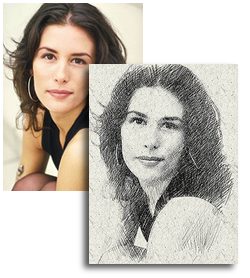
Tim Shelbourne writes...
Ask any artist and they'll tell you that all the tubes of paint in the world cannot replace the simple pencil when it comes to artistic potential. Through the centuries, the litmus test of an artist's ability was demonstrated best through the medium of drawing. In days of yore, student painters spent years drawing with graphite to hone their skills.
The so-called "Sketch Filters" in Photoshop consistently yield very disappointing results; re-creating the quintessential sketch demands a little more inventiveness and an approach that mimics traditional techniques. Pencil sketches work especially well when very soft leaded pencils are used on a tinted paper, with a few touches of white chalk here and there to heighten the tones. This is what we'll produce here, digitally.
Don't worry if your drawing abilities aren't up to snuff, all that's required here is the ability to scribble!
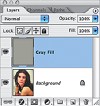 Note: Due to the size and number of diagrams, we've made these thumbnails clickable, and should open the actual diagram in a new, pop-up window. If they don't, be sure you have JAVA turned on, and Pop-up blocking turned off.
Note: Due to the size and number of diagrams, we've made these thumbnails clickable, and should open the actual diagram in a new, pop-up window. If they don't, be sure you have JAVA turned on, and Pop-up blocking turned off.
(1) Open your original image in Photoshop.
Go to Layer > New Fill Layer > Solid Color,
call it "Gray Fill," and click OK.
In the Color Picker, choose a light gray.
 (2) Click the "Create new fill or adjustment layer" icon at the base of the Layers palette and choose Pattern from the list.
(2) Click the "Create new fill or adjustment layer" icon at the base of the Layers palette and choose Pattern from the list.
Click in the Pattern Swatch in the dialog box, hit the right-pointing arrow, and select Grayscale Paper.
Choose Fibers 1 from the swatch.
Increase the Pattern Scale to 340% and click OK. Set this layer to
Soft Light, and 35% opacity.
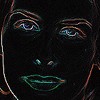 (3) Right-click/Ctrl-click the background layer and choose Duplicate Layer, calling the layer "Glowing Edges."
(3) Right-click/Ctrl-click the background layer and choose Duplicate Layer, calling the layer "Glowing Edges."
Drag this new layer to the top of the stack and go to
Filter > Stylize > Glowing Edges.
Use these values:
Edge Width 3, Edge Brightness 11, Smoothness 10.
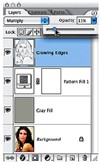 (4) Invert the Glowing Edges layer using
(4) Invert the Glowing Edges layer using
Image > Adjustments > Invert (Ctrl/Cmd+I).
This layer only needs to be black and white, so go to
Image > Adjustments > Desaturate (Ctrl/Cmd+Shift+U).
Set the layer's blending mode to Multiply with an opacity of 15%.
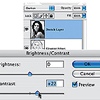 (5) Duplicate the background layer again, calling it "Sketch Layer," and drag this duplicate to the top of the stack.
(5) Duplicate the background layer again, calling it "Sketch Layer," and drag this duplicate to the top of the stack.
Desaturate this layer using Image
> Adjustments > Desaturate (Ctrl/ Cmd+Shift+U).
To use the layer as a base for the drawing, increase the contrast a little, by going to
Image > Adjustments > Brightness and Contrast. Drag the Contrast slider to the right to a value of 22.
Now set the layer blending mode to Darken and leave the opacity set to 100%.
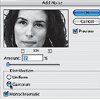 (6) We need to add some Noise to this layer to break the image up a little, so go to
(6) We need to add some Noise to this layer to break the image up a little, so go to
Filter > Noise > Add Noise.
Use an Amount of 12%, choose Gaussian for Distribution, and check Monochromatic.
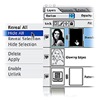 (7) Add a Hide All layer mask to this layer using Layer > Layer Mask > Hide All.
(7) Add a Hide All layer mask to this layer using Layer > Layer Mask > Hide All.
To make the drawing, simply scribble on this layer mask using a special brush.
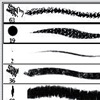 (8) Select the Brush tool and click in the Brush Picker.
(8) Select the Brush tool and click in the Brush Picker.
Click the right-pointing arrow in the Picker and choose Dry Media Brushes. Scroll down the thumbnails and double-click Pastel on Charcoal Paper.
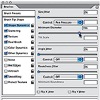 (9) Hit F5 on the keyboard to display the Brush Options.
(9) Hit F5 on the keyboard to display the Brush Options.
Click the Other Dynamics panel and set the Opacity Jitter Control box to Pen Pressure.
Click Shape Dynamics and set the Size Jitter to Pen Pressure.
Set Minimum Diameter to 70%.
Remember, if you are not using a graphics tablet, you must control the opacity of the Brush using the Opacity slider in the Options bar.
Article continues on the Next Page...
- This article is the exclusive property of O'Reilly Publishing and Ilex Press, Limited. © Copyright 2005 ALL RIGHTS RESERVED. All images are the exclusive property of Tim Shelbourne. ©Copyright 2005 ALL RIGHTS RESERVED
Tim Shelbourne worked for 20 years as a traditional artist and illustrator before converting to digital image making. Tim specializes in digital fine art and photo-manipulation using Adobe Photoshop, Illustrator, and Corel Painter. (consistently producing stunning Photographic Effects; Watercolor Paintings, Oil Paintings, special texture effects, and unique assemblages.) His tutorials are published regularly in Total Digital Photography magazine. (Back to top of article)
Also see:
Tim Shelbourne's Watercolor Effects from the Photoshop Photo Effects Cookbook - 61 Easy-to-Follow Recipes for Digital Photographers, Designers, and Artists (Download: 15 MB PDF Format)
Photoshop Blending Modes Cookbook for Digital Photographers with 48 Easy-to-Follow Recipes to Fix Problem Photos and Create Amazing Effects, By John Beardsworth ... Layer blending modes have been part of Photoshop for years, but they're not easy to understand at first glance. Sample Excerpt: Ultrawide Sharpening & Vibrant Mix (PDF Format)
Photoshop Retouching Cookbook for Digital Photographers with 113 Easy-to-Follow Recipes to Improve Your Photos and Create Special Effects By Barry Huggins ... tells you everything you need to know to adjust, correct, retouch, and manipulate your photographs-without making you first learn everything there is to know about Photoshop CS2. Sample Excerpt: Motion Blurring and Removing Skin Blemishes & Wrinkles (PDF Format)
Return to: Photoshop Tips & Tricks, or the Design Center Front Page
Participate in your Design Center
Lots of fun and information for all... don't forget, any community is only as good as the participation of its members. We invite your tips, tricks, comments, suggestions and camaraderie.- Ask for the DT&G Monthly: to receive DT&G newsletter each month, happenings in the Design Center and regular columns like the "Mail Bag" and "Cool Sites"
- SUBSCRIBE : to the Designers' CAFE email list
- Link to this site, and then show us the link. We'll send you any of our current door prizes, just for your trouble.

